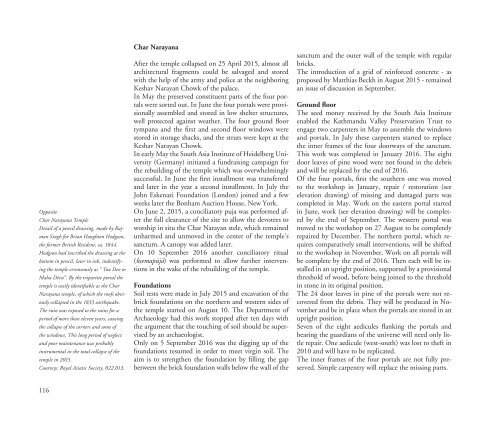KVPT’s Patan Darbar Earthquake Response Campaign - Work to Date - September 2016
You also want an ePaper? Increase the reach of your titles
YUMPU automatically turns print PDFs into web optimized ePapers that Google loves.
Opposite<br />
Char Narayana Temple<br />
Detail of a pencil drawing, made by Rajman<br />
Singh for Brian Hough<strong>to</strong>n Hodgson,<br />
the former British Resident, ca. 1844.<br />
Hodgson had inscribed the drawing at the<br />
bot<strong>to</strong>m in pencil, later in ink, indentifying<br />
the temple erroneously as “ Tou Deo or<br />
Maha Déva”. By the tripartite portal the<br />
temple is easily identifiable as the Char<br />
Narayana temple, of which the roofs obviously<br />
collapsed in the 1833 earthquake.<br />
The ruin was exposed <strong>to</strong> the rains for a<br />
period of more than eleven years, causing<br />
the collapse of the corners and some of<br />
the windows. This long period of neglect<br />
and poor maintenance was probably<br />
instrumental in the <strong>to</strong>tal collapse of the<br />
temple in 2015.<br />
Courtesy: Royal Asiatic Society, 022.013.<br />
Char Narayana<br />
After the temple collapsed on 25 April 2015, almost all<br />
architectural fragments could be salvaged and s<strong>to</strong>red<br />
with the help of the army and police at the neighboring<br />
Keshav Narayan Chowk of the palace.<br />
In May the preserved constituent parts of the four portals<br />
were sorted out. In June the four portals were provisionally<br />
assembled and s<strong>to</strong>red in low shelter structures,<br />
well protected against weather. The four ground floor<br />
tympana and the first and second floor windows were<br />
s<strong>to</strong>red in s<strong>to</strong>rage shacks, and the struts were kept at the<br />
Keshav Narayan Chowk.<br />
In early May the South Asia Institute of Heidelberg University<br />
(Germany) initiated a fundraising campaign for<br />
the rebuilding of the temple which was overwhelmingly<br />
successful. In June the first installment was transferred<br />
and later in the year a second installment. In July the<br />
John Eskenazi Foundation (London) joined and a few<br />
weeks later the Bonham Auction House, New York.<br />
On June 2, 2015, a concilia<strong>to</strong>ry puja was performed after<br />
the full clearance of the site <strong>to</strong> allow the devotees <strong>to</strong><br />
worship in situ the Char Narayan stele, which remained<br />
unharmed and unmoved in the center of the temple’s<br />
sanctum. A canopy was added later.<br />
On 10 <strong>September</strong> <strong>2016</strong> another concilia<strong>to</strong>ry ritual<br />
(kṣemapūjā) was performed <strong>to</strong> allow further interventions<br />
in the wake of the rebuilding of the temple.<br />
Foundations<br />
Soil tests were made in July 2015 and excavation of the<br />
brick foundations on the northern and western sides of<br />
the temple started on August 10. The Department of<br />
Archaeology had this work s<strong>to</strong>pped after ten days with<br />
the argument that the <strong>to</strong>uching of soil should be supervised<br />
by an archaeologist.<br />
Only on 5 <strong>September</strong> <strong>2016</strong> was the digging up of the<br />
foundations resumed in order <strong>to</strong> meet virgin soil. The<br />
aim is <strong>to</strong> strengthen the foundation by filling the gap<br />
between the brick foundation walls below the wall of the<br />
sanctum and the outer wall of the temple with regular<br />
bricks.<br />
The introduction of a grid of reinforced concrete - as<br />
proposed by Matthias Beckh in August 2015 - remained<br />
an issue of discussion in <strong>September</strong>.<br />
Ground floor<br />
The seed money received by the South Asia Institute<br />
enabled the Kathmandu Valley Preservation Trust <strong>to</strong><br />
engage two carpenters in May <strong>to</strong> assemble the windows<br />
and portals. In July these carpenters started <strong>to</strong> replace<br />
the inner frames of the four doorways of the sanctum.<br />
This work was completed in January <strong>2016</strong>. The eight<br />
door leaves of pine wood were not found in the debris<br />
and will be replaced by the end of <strong>2016</strong>.<br />
Of the four portals, first the southern one was moved<br />
<strong>to</strong> the workshop in January, repair / res<strong>to</strong>ration (see<br />
elevation drawing) of missing and damaged parts was<br />
completed in May. <strong>Work</strong> on the eastern portal started<br />
in June, work (see elevation drawing) will be completed<br />
by the end of <strong>September</strong>. The western portal was<br />
moved <strong>to</strong> the workshop on 27 August <strong>to</strong> be completely<br />
repaired by December. The northern portal, which requires<br />
comparatively small interventions, will be shifted<br />
<strong>to</strong> the workshop in November. <strong>Work</strong> on all portals will<br />
be complete by the end of <strong>2016</strong>. Then each will be installed<br />
in an upright position, supported by a provisional<br />
threshold of wood, before being joined <strong>to</strong> the threshold<br />
in s<strong>to</strong>ne in its original position.<br />
The 24 door leaves in pine of the portals were not recovered<br />
from the debris. They will be produced in November<br />
and be in place when the portals are s<strong>to</strong>red in an<br />
upright position.<br />
Seven of the eight aedicules flanking the portals and<br />
bearing the guardians of the universe will need only little<br />
repair. One aedicule (west-south) was lost <strong>to</strong> theft in<br />
2010 and will have <strong>to</strong> be replicated.<br />
The inner frames of the four portals are not fully preserved.<br />
Simple carpentry will replace the missing parts.<br />
116




